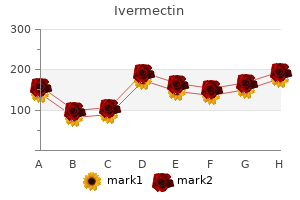Ivermectin
Kathleen Elizabeth Batley, MD
- Medical Instructor in the Department of Medicine

https://medicine.duke.edu/faculty/kathleen-elizabeth-batley-md
Over reliance on refined enteral formulas virus 912 ivermectin 6 mg buy amex, and inadequate fluid provision can also contribute to constipation antimicrobial silver gel ivermectin 12 mg order overnight delivery. If actual fecal impaction occurs length of antibiotics for sinus infection purchase 3 mg ivermectin mastercard, secondary obstructive symptoms may be misinterpreted as proximal gut motility abnormalities fish antibiotics for sinus infection purchase ivermectin 3 mg with amex, diverting the clinician away from the need for disimpaction prior to treatment or evaluation of proximal gut dysmotility (41). This can occur along anastomotic lines or be due to bleeding at a gastrostomy site, mechanical erosion from indwelling enteric catheters or associated stress ulcers. Bacterial overgrowth (42) and potentially protein sensitive enteropathy can antagonize blood loss. The effects of anastomotic inflammation and bacterial overgrowth probably render the gut more susceptible to the development of protein sensitive enteropathy because they allow absorption of intact protein across the gut with consequent sensitization. Inadequate gut length for absorption of iron, folic acid, vitamin B12 and/or copper can hinder efforts to improve secondary anemia in short bowel syndrome. Minimizing fluid and electrolyte loss, supplementation with appropriate vitamin, mineral and other nutrients such as glutamine and fiber can play a pivotal role in preventing nutritional deficiencies and optimizing clinical outcomes. Careful monitoring of nutritional status and growth velocity on a long term basis are key components to success in nutritional and medical management. Factors correlating with a successful outcome following extensive intestinal resection in newborn infants. Immediate commencement of amino acid supplementation of preterm infants: effect on serum amino acid concentration and protein kinetics on the first day of life. Effect of intravenous amino acids on protein metabolism of preterm infants during the first three days of life. Cysteine supplementation results in normalization of plasma taurine concentrations in children receiving home parenteral nutrition. The clinical management of short bowel syndrome: steps to avoid parenteral nutrition. Effect of high percentage medium-chain triglyceride diet on mucosal adaptation following massive bowel resection in rats. Effect of dietary menhaden oil on normal growth and development and on ameliorating mucosal injury in the rat. Nutritional and other postoperative management of neonates with short bowel syndrome correlates with clinical outcomes. Intolerance to protein hydrolysate infant formulas: An underrecognized cause of gastrointestinal symptoms in infants. Enteral glutamine supplementation for very low birth weight infants decreases morbidity. Growth hormone, glutamine, and a modified diet enhance nutrient absorption in patients with severe short bowel syndrome. Central venous catheter related thrombosis in children: analysis of the Canadian Registry of Venous Thromboembolic Complications. Colonic preservation reduces need for parenteral therapy, increases incidence of renal stones, but does not change high prevalence of gall stones in patients with a short bowel. Infection and cholestasis in neonates with intestinal resection and long-term parenteral nutrition. Intestinal malrotation: the role of small intestinal dysmotility in the cause of persistent symptoms. Influence of bacterial overgrowth and intestinal inflammation on duration of parenteral nutrition in children with short bowel syndrome J Pediatr, 1997; 131(3): 356361. University of Virginia Health System Nutrition Support Traineeship Syllabus, January 2003. According to Rosai and Levine,1 it should be emphasized that the term "thymoma" is restricted to neoplasms of the thymic epithelial cells. A detailed historical review of the thymus gland and thymomas has been published by Givel.
Syndromes
- Low blood pressure
- Fluorescent in situ hybridisation (FISH) -- looks for small mistakes such as deletions in the chromosomes
- Magnetic resonance imaging (MRI) of the abdomen
- Abscess
- Do you have any other symptoms such as numbness, tingling, back pain, or fever?
- Fainting or feeling light-headed

Adult - 20-50 years Urethral stricture; Calculi (bladder and urethral stones); Bladder tumours; Ruptured urethra (trauma); Post-operative (any perinea! Females Bladder tumours; calculi; pelvic tumours (Cancer cervix antibiotic yeast infection prevention order 12 mg ivermectin fast delivery, etc); urethral stenosis; clot retention (severe haematuria) antibiotic resistance zone diameter discount 6 mg ivermectin amex. Try catheterization again if fails use cystofix or suprapubic cystostomy and refer antibiotic resistant infections ivermectin 3 mg mastercard. This is specialised treatment for which the patient should be referred to a surgeon antibiotic resistance occurs quickly because ivermectin 3 mg for sale. As this may not always be possible, the alternative is to do a suprapubic cystotomy and insert a catheter and refer. Procedure for Suprapubic Cystotomy this is done under strict aseptic precondition. Clinical Features the bladder may be injured intraperitoneally or extraperitoneally. Extraperitoneal Rupture Similar symptoms like in rupture of posterior urethra described above. Predisposing Factors Obstruction in the urinary tract due to prostatic enlargement, pregnant uterus, calculi (stones), vesicoureteric reflux, cervical prolapse, cystocele, tumours. Interpret results as follows: - <10,000 - nonspecific contaminants - 10,000-100,000; doubtful significance. Clinical Features ~ Children Neonates Boys are affected more than girls due to higher incidence of congenital urinary malformation, Non-specific symptoms; Irritability, poor feeding, vomiting. Pyuria as an isolated finding is almost commonly associated with bacterial urinary tract infection. When associated with haematuria or proteinuria, pyuria is suggestive of parenchymal renal disease such as glomerulonephritis or interstitial nephritis. Acute Glomerulonephritis this is an inflammatory renal disease commonly following streptococcal infection of skin and tonsils. Acute Renal Failure Acute or subacute decline in the glomerular filtration rate and/or tubular function characterised by rapid accumulation of nitrogenous waste products. Chronic Renal Failure the term chronic renal failure describes the existence of irreversibly advanced and usually progressive renal failure. Usually, there are no clinical consequences until the levels rise to 6 mmol/L and above. Causes include acute renal failure, severe chronic renal failure, and use of potassium retaining drugs. Causes include inadequate dietary intake (rare), gastrointestinal fluid loss (vomiting, diarrhoea, fistulae, paralytic ileus), renal loss (diuretics, uncontrolled diabetes mellitus), systemic metabolic alkalosis, and dialysis. Urinary Fistula Abnormal communication between urinary system and skin or internal hollow viscus. Syr 200mg base/5ml (100ml) Cephalexin syrup 125mg/5ml (100ml) Ampicillin/Cloxacillin Neonatal drops 60mg/30mg (10ml) 6. Frusemide Tabs 40mg Hydrochlorothiazide Tabs 50mg Mannitol Inj 20% (500ml) Spironolactone Tabs 25mg 17.
Cheap ivermectin 3 mg amex. A History of Antimicrobial Silver.

Hypotension antibiotics for dogs abscess discount ivermectin 3 mg amex, bradycardia antibiotics for sinus infection over the counter generic 6 mg ivermectin free shipping, dyspnea infection 68 ivermectin 12 mg for sale, and transitory flushing have been reported in adults [2] antibiotic bomb 6 mg ivermectin free shipping. Monitoring Monitor vital signs, clotting functions, and blood pressure continuously. Uses Treatment of patients with severe congenital protein C deficiency for the prevention and treatment of venous thrombosis and purpura fulminans. Also indicated as a 704 Micormedex NeoFax Essentials 2014 replacement therapy [1] [2] [3] [4]. Pharmacology Protein C, a precursor of a vitamin K-dependent anticoagulant glycoprotein, is activated by the thrombin/thrombomodulin-complex on the endothelial cell surface resulting in subsequent potent anticoagulant effects. Limited data also suggests a faster clearance and larger volume of distribution in young children which may lead to significantly reduced Cmax and therefore, reduced systemic exposure compared to older subjects [1] [3]. Most serious and common adverse events reported were hypersensitivity or allergic reactions and lightheadedness. Special Considerations/Preparation Available in single-dose vials that contain nominally 500 (blue color bar) or 1000 (green color bar) international units human protein C. Dose regimen should be adjusted to maintain a target peak protein C activity of 100%. After resolution of acute episode, maintain trough protein C activity level above 25% for duration of treatment. For patients beginning warfarin therapy (vitamin K antagonist therapy), continue protein C until stable anticoagulation is achieved. Pharmacology 706 Micormedex NeoFax Essentials 2014 Protein C, a precursor of a vitamin K-dependent anticoagulant glycoprotein, is activated by the thrombin/thrombomodulin-complex on the endothelial cell surface resulting in subsequent potent anticoagulant effects. Adverse Effects Patients receiving protein C and initiating oral anticoagulant therapy are at increased risk for warfarin-induced skin necrosis. Patients with renal impairment may experience sodium overload (contains greater than 200 mg of sodium in maximum daily dose) [1]. During acute thrombotic events, measure protein C activity immediately before the next dose until the patient is stabilized; dose regimen should be adjusted to maintain a target peak protein C activity of 100% (1 international unit/mL). Closely monitor patients with renal impairment for sodium overload (contains greater than 200 mg of sodium in maximum daily dose) [1] [3]. Vials should be brought to room temperature and reconstituted with 5 mL and 10 mL of sterile water for injection, respectively, to provide a concentration of 100 international units/mL. When reconstituted, contains the following excipients: human albumin 8 mg/mL, trisodium citrate dihydrate 4. Dreyfus M, Masterson M, David M et al: Replacement therapy with a monoclonal antibody purified protein C concentrate in newborns with severe congenital protein C deficiency. Pyridoxine and antiepileptics are then withdrawn, followed by a reoccurrence of clinical seizures that are, again, successfully treated with pyridoxine monotherapy [4] [5] [1] [2] [3]. They typically present in the neonatal period or early infancy; however, seizures can occur for the first time at up to 3 years of age. Pharmacology Pyridoxine is a coenzyme in amino acid and carbohydrate metabolism required for the conversion of tryptophan to both niacin and neurotransmitter serotonin and conversion of dopa to dopamine. In addition to seizures, presentation may include hypothermia, jitteriness, encephalopathy, abdominal distension, and vomiting. Cardiorespiratory monitoring is recommended and ventilator support may be necessary with initial administration of pyridoxine. A pyridoxine level than less 20 nanomoles/L is indicative of deficiency [7] Special Considerations/Preparation Injectable form available in concentration of 100 mg/mL (1 mL in 2-mL vial). Uses Limited to treatment of infections caused by gram positive organisms resistant to other antibiotics, eg, methicillin-resistant Staph. Synercid is a parenteral antimicrobial agent which consists of two streptogramin antibiotics (quinupristin and dalfopristin in a 30:70 ratio) that inhibit bacterial protein synthesis by binding to separate sites on the bacterial ribosome. Adverse Effects Myalgias and arthralgias occur frequently in adults with hepatic or renal failure. Concentrations less than 1 712 Micormedex NeoFax Essentials 2014 mg/mL may be used if venous irritation occurs following peripheral administration. Diluted solution is stable for 5 hours at room temperature, or 54 hours if stored under refrigeration. Terminal Injection Site Compatibility Aztreonam, fluconazole, metoclopramide, and potassium chloride. Serum half-life of quinupristin in adults ranges from 1 to 3 hours, and of dalfopristin ranges from 5 to 9 hours.
Diseases
- Koone Rizzo Elias syndrome
- Mengel Konigsmark syndrome
- Iduronate 2-sulfatase deficiency
- Horseshoe kidney
- Activated protein C resistance
- Van Bogaert Hozay syndrome
- Mucolipidosis type 4
- Hyperoxaluria type 2
References
- Subramanian, K. (1991b). Structured group work for the management of chronic pain: An experimental investigation. Research on Social Work Practice, 4, 32n45.
- Hsu RB, Chen RJ, Wang SS, et al: Infected aortic aneurysms: clinical outcome and risk factor analysis, J Vasc Surg 40:30, 2004.
- Griebling TL: Detrusor underactivity and urinary retention in geriatric patients: evaluation, management and recent research, Curr Bladder Dysfunct Rep 8:92n100, 2013. Griebling TL, editor: Geriatric urology, New York, 2014a, Springer. Griebling TL: Incontinence guidelines: is lack of adherence a form of ageism?, Nat Rev Urol 8:655n657, 2011.
- Norris, R.D., Sur, R.L., Springhart, W.P. et al. A prospective, randomized, double-blinded placebo-controlled comparison of extended release oxybutynin versus phenazopyridine for the management of postoperative ureteral stent discomfort. Urology 2008;71:792-795.
- Labovitz AJ: Pearson: Historical perspectives and technical considerations. In Transesophageal echocardiography: Basic principles and clinical implications, Philadelphia, 1993, Lea and Febiger, pp 1-11.
- Ferreri AJ, Guerra E, Regazzi M, et al. Area under the curve of methotrexate and creatinine clearance are outcomedetermining factors in primary CNS lymphomas. Br J Cancer 2004;90(2):353-358.
- Bai Y, Miller T, Tan M, et al: Lidocaine patch for acute pain management: a meta-analysis of prospective controlled trials. Curr Med Res Opin 31: 575-581, 2015.
